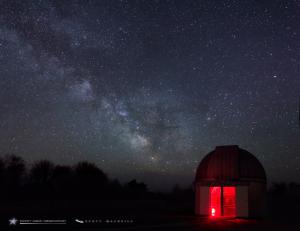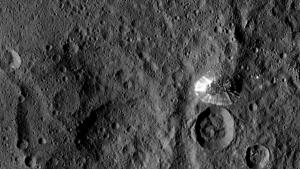
Summer Stargazing Nights
- Where:
- Frosty Drew Observatory
- When:
- Friday August 28, 2015 at 6:00 p.m.
- Cost:
- $1 Suggested Donation per Person
Tonight's forecast is calling for mostly clear to clear skies all night. The 98% waxing gibbous Moon, one day away from full, will blaze our skies with blindingly bright moonlight. Though the bright Moon will plunder our super dark starscape of nebulae, galaxies, and star clusters; an excellent night of viewing will be had by all who visit. This will also be the last Friday of the Frosty Drew Observatory summer season with a full production as next weekend (Labor Day Weekend) will bring the awesome Rhythm and Roots festival to Ninigret Park, which we will certainly open for but will be in party mode.
The Observatory and Sky Theatre will open at 6:00 p.m. tonight. In the Observatory, departing views of the huge sunspot, AR2403 will be on display. Once the Sun sets, we will direct our telescopes towards the night sky. Saturn will be rocking our view in the main telescope until it sets around 11:00 p.m. The Moon will be on display in telescopes throughout the night for those looking to bask their eyes in massive moonlight. We will stay until at least 11:30 p.m., possibly later if we are rocking it. Tonight will be the last night we open the Frosty Drew Nature Center for the Summer 2015 Stargazing season and will start at 7:00 p.m. continuing until 10:00 p.m. with Naturalists on hand to get their geek on with you. The Sky Theatre will feature our popular astrophoto showcase with the Lunar Lounge showing the New Horizons Pluto Encounter and possibly live views of the Moon.
Though the Moon will be strikingly bright, tonight presents an excellent opportunity to get your geek on in full swing end-of-summer mode. So come out, shake off those back to school blues, and catch a last chance summer astro-fix under the super bright Moon at Frosty Drew Observatory tonight!
-------------------------------------------------------------------------
Weekly Happenings
Scott MacNeill
The NASA Dawn mission, which is now taking up residence at dwarf planet Ceres in the Asteroid Belt, has been rocking its new mapping orbit. At an altitude of 915 miles above Ceres surface the Dawn spacecraft is capturing amazingly detailed images of features on Ceres surface. This is Dawn's third mapping altitude and at this altitude it takes 14 orbits over 11 days to map the entire surface of Ceres. Each image collected by Dawn's framing camera will have a resolution of 450 feet per pixel. Dawn will continue to map Ceres surface six times at this altitude enabling the creation of a full 3D map of the surface of Ceres. Additionally, Dawn's visible and infrared spectrometer is collecting data on the mineral composition of Ceres surface. Descent to the final mapping altitude will commence in October 2015 when Dawn will move to an altitude of 230 miles above Ceres surface. Check out some of the awesome images coming back from this new mapping altitude.
Tomorrow afternoon at 2:35 p.m. EDT, the full Moon of August will take place. Also known as the Full Sturgeon Moon, because early Native American tribes would find the easiest catches of large sturgeon fish in the larger lakes of North America this time of year, this lunar display is also a Supermoon. A supermoon happens when the full lunar phase occurs withing 24 hours of the Moon's closest point in its orbit around Earth (called perigee). Sunday morning, the Moon will reach perigee at 11:25 EDT, which is less than 24 hours past the full phase on Saturday afternoon at 2:35 EDT. So Supermoon! Visit Frosty Drew Observatory tomorrow night and have a geek out moment with the first Supermoon of 2015.
-Scott


